Home / Past Newsletters / March 2013
March 2013
Summer is coming to an end, so we have recipes to succour summer skin, soothe sore muscles (now that the weather is cool enough to be really energetic), and a balm to help see off those autumn bugs that will soon be making the most of the cool and damp. (I just looked up that word 'succour', wondering why it popped into my mind: it means "to give assistance to, in time of need or distress". After all that heat and dry, many of us have skin in need of a special balm or cream.)
In this issue:
Recipes: a balm and a cream
Chelsea made a great balm recipe for Christmas presents last year. She packaged them in our wide-mouth 200g jars which looked great.
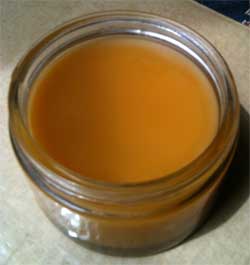
Chelsea Balm
100g wildcrafted shea butter
100g organic natural rosehip oil
Melt the shea butter very gently, add the rosehip oil, pour into a container and leave to set.
The natural rosehip oil gave the balm a lovely golden colour.
Chelsea needed a few more presents (Xmas Eve!), momentarily forgot what she used first time around, so used wild shea butter and jojoba oil.
I’ve noticed the brand Badger Balm creeping in to NZ.
Great quality too.
However, apart from cute packaging, there is never any need to buy a balm.
They are SO simple to make!
Basic recipe for 100g:
85g carrier oil & essential/fragrance oil
15g beeswax
Here's the ingredient list from Badger Balm’s Sore Muscle Rub.
Labelling rules require ingredients to be listed in volume order.
Olive oil
Beeswax
Castor oil
Eucalyptus essential oil
Peppermint essential oil
Camphor essential oil
Cajeput essential oil
Clove essential oil
Go Native substitution:
Go Native Muscle Rub
55g olive oil
15g beeswax
10g castor oil
10g eucalyptus blue gum essential oil
4g peppermint essential oil (piperita or arvensis)
3g camphor essential oil
2g cajeput essential oil
1g clove bud essential oil
For a rub with extra punch, add 5g chilli seed essential oil and make olive oil 50g.
To make: Melt the olive oil, beeswax and castor oil gently. Take off the heat and add the essential oils. Pour into a pot and let set.
Here's another good balm, for winter coughs and colds, a Vicks lookalike.
Go Native Winter Balm – for coughs and colds
40g olive oil
15g castor oil
15g beeswax
12g camphor essential oil
10g menthol crystals
8g eucalyptus blue gum essential oil
Melt the olive oil, beeswax and castor oil gently. Add the menthol crystals and stir until they have melted. Add the rest, pour into a container and leave to set.
A note: Any oil can be substituted for olive oil. Olive oil is often used as it’s a good all-round cheap oil. It’s only there to ‘carry’ the other ingredients into your skin (hence, carrier oil).
Castor oil is a wonderful moisturiser. But other oils could be substituted for it, for example macadamia oil or pomegranate oil.
Cold-pressed virgin oils from New Zealand
We are proud to offer you several wonderful oils from New Zealand growers.
In this newsletter we are featuring hazelnut oil, but we also have: All of these oils have been produced with great care, and have a liveliness about them that makes them a delight to use.
Hazelnut Oil
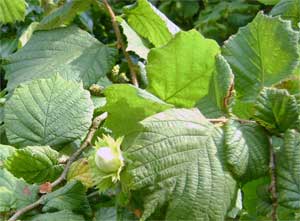 I love the sight, smell and taste of hazelnuts. I’m taken back to a time when I was travelling on my own, and arrived back in England in the autumn. I followed footpaths along the coast from Dover, sleeping under hedges and living on the bounty of the hedgerows. Hazelnuts were everywhere, sustaining and delicious.
I love the sight, smell and taste of hazelnuts. I’m taken back to a time when I was travelling on my own, and arrived back in England in the autumn. I followed footpaths along the coast from Dover, sleeping under hedges and living on the bounty of the hedgerows. Hazelnuts were everywhere, sustaining and delicious.
Hazelnuts grow well in the cooler parts of New Zealand, and we are lucky enough to have some beautiful and well-priced oil from South Island groves. Our cold-pressed virgin oil has a distinctive hazelnut aroma, but this fades quite quickly once it is applied to the skin.
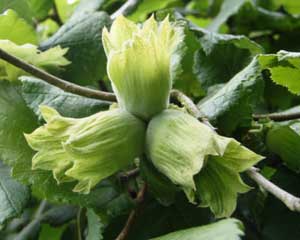
Hazelnut oil is a wonderfully versatile oil, with many skincare and bodycare uses. Naturally occurring antioxidants ensure a good shelf life – it will keep for three to four years if stored cool and dark. (Note: the expiry date on our labels is much shorter than this, as we want to ensure that you will be using the oil in top condition.)
Skincare
It’s one of those oils that has a luxurious feel on the skin. Easily absorbed, it leaves no hint of greasiness.
Hazelnut oil nourishes the skin with a range of fatty acids and other nutrients. Its vitamin E content provides protection against free radicals, and makes it useful for helping prevent stretch marks and scarring.
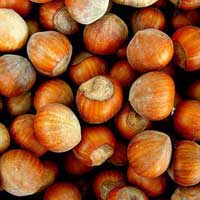 French research has shown that virgin hazelnut oil contains far greater amounts of phospholipids than the refined oil. Lipids occur naturally in the skin – they include the emollient waxes and oils that moisturise and protect. The phospholipids found in hazelnut oil are similar to these, so are easily absorbed, helping to repair damaged skin and hydrate dry skin. They help strengthen cell membranes, increasing skin resilience.
French research has shown that virgin hazelnut oil contains far greater amounts of phospholipids than the refined oil. Lipids occur naturally in the skin – they include the emollient waxes and oils that moisturise and protect. The phospholipids found in hazelnut oil are similar to these, so are easily absorbed, helping to repair damaged skin and hydrate dry skin. They help strengthen cell membranes, increasing skin resilience.
Hazelnut oil is great in oil blends and creams for a wide range of conditions and situations:
Hair care
Commbine hazelnut oil with organic jojoba oil and massage into hair, a teaspoon at a time. Cover with an old shower cap, or wrap with plastic wrap, and leave for several hours before shampooing as usual.
For dry hair, include up to 30% kiwi seed oil.
For dandruff, include up to 40% walnut oil.
Massage
At around 85% monounsaturated fatty acids (omega 7 and 9), hazelnut oil is great in massage blends as it spreads easily and provides good lubrication.
Also include some blackcurrant seed oil for its anti-inflammatory qualities – it will help to ease aches and pains.
Aromatherapy
Hazelnut oil is recommended as a base for essential oils in aromatherapy.

Grams or mls? Weight or volume?
It’s like daylight saving – forward or back? – fine if you just do it, but the more you think about it, the trickier it gets.
We weigh out things that are solid, but most liquids are measured in mls, i.e. how much space they take up.
So if you buy coconut oil or borax, it will have been on the scales.
If you buy almond oil, you will get 500ml or a litre – you choose a volume, not a weight.
To the left of the photo is 200g of olive oil; on the right is 200ml. What's going on? Read on!
The metric system of weights and measures was literally revolutionary - it developed in the decade after the French Revolution in 1789, when the idea of a society based on logic and equality and universal truths overwhelmed the tradition of power based on inherited wealth.
A “litre” of pure water was defined as weighing one “kilogram” – 1000 “grams” – and so one “millilitre” (ml) of water weighs one gram. It can be tricky to get your head around the 1000 thing, but it’s far simpler than all the ancient systems of pecks and feet and bushels and furlongs. (Interesting that Americans are still very attached to gallons and quarts – but the rest of the world has embraced the metric system for its clarity and logic.)
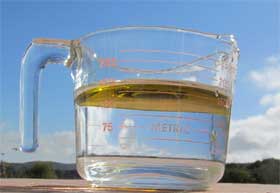 But - there’s a big BUT – grams and mls are only the same for water.
But - there’s a big BUT – grams and mls are only the same for water.
Think about what happens when you make a vinaigrette dressing – that pesky oil goes straight to the top and floats there.
Yes, oil is lighter than water. In the photo, olive oil is floating on water.
So when you buy 500g of coconut oil, you are going to get a bigger volume than when you buy 500ml of avocado oil.
Next time you’re wondering if you’ve got your full whack of something, check: Is it sold by weight or by volume? It’s more likely that you’ve got a bit much.
Mouse deterrent
This is the time of the year when the mice and rats begin to look for a cosy wintering spot.
If you have a rambling house with potential mouse hideouts, or a garage where they like to hide, you may like to try Hiyam's favourite rodent deterrent: peppermint oil. Try putting a little on a scrap of fabric or something absorbent, near the spots that mice like.
Thank you, Hiyam.
If you have any unusual ways of using our oils, we'd love to hear from you!
Hope you get a chance to experiment with a new recipe or a new oil blend over Easter - have fun!
Kind regards
Elinor, Chelsea, & Jacqui
In this issue:
- Recipes: Chelsea Balm, Summer Cream
- Two jars of Summer Cream to give away
- Badger Balm substitution: Go Native Sore Muscle Rub
- Recipe: Winter Balm (for coughs and colds)
- Oils from New Zealand: hazelnut oil, pumpkin seed oil, and more
- Measuring oils: Weight or volume?
- Peppermint oil as a mouse deterrent
Recipes: a balm and a cream
Chelsea made a great balm recipe for Christmas presents last year. She packaged them in our wide-mouth 200g jars which looked great.

Chelsea Balm
100g wildcrafted shea butter
100g organic natural rosehip oil
Melt the shea butter very gently, add the rosehip oil, pour into a container and leave to set.
The natural rosehip oil gave the balm a lovely golden colour.
Chelsea needed a few more presents (Xmas Eve!), momentarily forgot what she used first time around, so used wild shea butter and jojoba oil.
It was nice but didn’t have the rich golden colour of the original batch and didn’t look nearly as nice in the pot.
I (Elinor) made a cream over summer. Was going to call it Summer Cream. Bit late now! Autumn Cream doesn’t have quite the same ring to it. My imagination has left me so here goes:
Lavender Summer Cream
(Makes about 500g)
Water Phase:
330g water
26g glycerin
14g aloe vera gel
Oil Phase:
50g shea butter
26g peach kernel oil
24g argan oil
30g emulsifying wax NF
Last Phase:
0.5g Geogard 221
0.5g lavender essential oil
Method:
Substitution: Badger Balm's Sore Muscle RubI (Elinor) made a cream over summer. Was going to call it Summer Cream. Bit late now! Autumn Cream doesn’t have quite the same ring to it. My imagination has left me so here goes:
Lavender Summer Cream
(Makes about 500g)
Water Phase:

330g water
26g glycerin
14g aloe vera gel
Oil Phase:
50g shea butter
26g peach kernel oil
24g argan oil
30g emulsifying wax NF
Last Phase:
0.5g Geogard 221
0.5g lavender essential oil
Method:
- Heat the Water Phase and Oil Phase in separate pots to 65°C.
- Pour the Oil Phase into the Water Phase and blend with a stick blender on and off until it begins to thicken.
- Add the Last Phase ingredients and blend.
- When you are sure it is going to thicken and not separate, spoon into pots.
I’ve noticed the brand Badger Balm creeping in to NZ.
Great quality too.
However, apart from cute packaging, there is never any need to buy a balm.
They are SO simple to make!
Basic recipe for 100g:
85g carrier oil & essential/fragrance oil
15g beeswax
Here's the ingredient list from Badger Balm’s Sore Muscle Rub.
Labelling rules require ingredients to be listed in volume order.
Olive oil
Beeswax
Castor oil
Eucalyptus essential oil
Peppermint essential oil
Camphor essential oil
Cajeput essential oil
Clove essential oil
Go Native substitution:
- Beeswax will be 15g.
- The essential oils for a rub will be around 20g.
- We are left with 65g for the olive and castor oils. Castor comes below the beeswax on the ingredients’ listing so must be 15g or less. Let’s make it 10g and olive oil 55g.
- How do you apportion the 20g to the essential oils? You could go for 4g each. I would go for 10g eucalyptus, 4g for peppermint, 3g for camphor, 2g for cajeput and 1g for clove because more eucalyptus will give the rub more punch.
Go Native Muscle Rub
55g olive oil
15g beeswax
10g castor oil
10g eucalyptus blue gum essential oil
4g peppermint essential oil (piperita or arvensis)
3g camphor essential oil
2g cajeput essential oil
1g clove bud essential oil
For a rub with extra punch, add 5g chilli seed essential oil and make olive oil 50g.
To make: Melt the olive oil, beeswax and castor oil gently. Take off the heat and add the essential oils. Pour into a pot and let set.
Here's another good balm, for winter coughs and colds, a Vicks lookalike.
Go Native Winter Balm – for coughs and colds
40g olive oil
15g castor oil
15g beeswax
12g camphor essential oil
10g menthol crystals
8g eucalyptus blue gum essential oil
Melt the olive oil, beeswax and castor oil gently. Add the menthol crystals and stir until they have melted. Add the rest, pour into a container and leave to set.
A note: Any oil can be substituted for olive oil. Olive oil is often used as it’s a good all-round cheap oil. It’s only there to ‘carry’ the other ingredients into your skin (hence, carrier oil).
Castor oil is a wonderful moisturiser. But other oils could be substituted for it, for example macadamia oil or pomegranate oil.
Cold-pressed virgin oils from New Zealand
We are proud to offer you several wonderful oils from New Zealand growers.
In this newsletter we are featuring hazelnut oil, but we also have: All of these oils have been produced with great care, and have a liveliness about them that makes them a delight to use.
Hazelnut Oil
 I love the sight, smell and taste of hazelnuts. I’m taken back to a time when I was travelling on my own, and arrived back in England in the autumn. I followed footpaths along the coast from Dover, sleeping under hedges and living on the bounty of the hedgerows. Hazelnuts were everywhere, sustaining and delicious.
I love the sight, smell and taste of hazelnuts. I’m taken back to a time when I was travelling on my own, and arrived back in England in the autumn. I followed footpaths along the coast from Dover, sleeping under hedges and living on the bounty of the hedgerows. Hazelnuts were everywhere, sustaining and delicious.Hazelnuts grow well in the cooler parts of New Zealand, and we are lucky enough to have some beautiful and well-priced oil from South Island groves. Our cold-pressed virgin oil has a distinctive hazelnut aroma, but this fades quite quickly once it is applied to the skin.

Hazelnut oil is a wonderfully versatile oil, with many skincare and bodycare uses. Naturally occurring antioxidants ensure a good shelf life – it will keep for three to four years if stored cool and dark. (Note: the expiry date on our labels is much shorter than this, as we want to ensure that you will be using the oil in top condition.)
Skincare
It’s one of those oils that has a luxurious feel on the skin. Easily absorbed, it leaves no hint of greasiness.
Hazelnut oil nourishes the skin with a range of fatty acids and other nutrients. Its vitamin E content provides protection against free radicals, and makes it useful for helping prevent stretch marks and scarring.
 French research has shown that virgin hazelnut oil contains far greater amounts of phospholipids than the refined oil. Lipids occur naturally in the skin – they include the emollient waxes and oils that moisturise and protect. The phospholipids found in hazelnut oil are similar to these, so are easily absorbed, helping to repair damaged skin and hydrate dry skin. They help strengthen cell membranes, increasing skin resilience.
French research has shown that virgin hazelnut oil contains far greater amounts of phospholipids than the refined oil. Lipids occur naturally in the skin – they include the emollient waxes and oils that moisturise and protect. The phospholipids found in hazelnut oil are similar to these, so are easily absorbed, helping to repair damaged skin and hydrate dry skin. They help strengthen cell membranes, increasing skin resilience.Hazelnut oil is great in oil blends and creams for a wide range of conditions and situations:
- Baby skin – combine with equal quantities of kiwi seed oil and organic rosehip oil
- Sensitive or damaged skin – combine with blackcurrant oil and peach or apricot kernel oil
- Mature skin – combine with kiwi seed oil and avocado oil, pumpkin seed oil and/or walnut oil
- Oily or acne-prone skin – combine with kiwi seed oil
- Combination skin – combine with kiwi seed oil
Hair care

Commbine hazelnut oil with organic jojoba oil and massage into hair, a teaspoon at a time. Cover with an old shower cap, or wrap with plastic wrap, and leave for several hours before shampooing as usual.
For dry hair, include up to 30% kiwi seed oil.
For dandruff, include up to 40% walnut oil.
Massage
At around 85% monounsaturated fatty acids (omega 7 and 9), hazelnut oil is great in massage blends as it spreads easily and provides good lubrication.
Also include some blackcurrant seed oil for its anti-inflammatory qualities – it will help to ease aches and pains.
Aromatherapy
Hazelnut oil is recommended as a base for essential oils in aromatherapy.

Grams or mls? Weight or volume?
It’s like daylight saving – forward or back? – fine if you just do it, but the more you think about it, the trickier it gets.
We weigh out things that are solid, but most liquids are measured in mls, i.e. how much space they take up.
So if you buy coconut oil or borax, it will have been on the scales.
If you buy almond oil, you will get 500ml or a litre – you choose a volume, not a weight.
To the left of the photo is 200g of olive oil; on the right is 200ml. What's going on? Read on!
The metric system of weights and measures was literally revolutionary - it developed in the decade after the French Revolution in 1789, when the idea of a society based on logic and equality and universal truths overwhelmed the tradition of power based on inherited wealth.
A “litre” of pure water was defined as weighing one “kilogram” – 1000 “grams” – and so one “millilitre” (ml) of water weighs one gram. It can be tricky to get your head around the 1000 thing, but it’s far simpler than all the ancient systems of pecks and feet and bushels and furlongs. (Interesting that Americans are still very attached to gallons and quarts – but the rest of the world has embraced the metric system for its clarity and logic.)
 But - there’s a big BUT – grams and mls are only the same for water.
But - there’s a big BUT – grams and mls are only the same for water.Think about what happens when you make a vinaigrette dressing – that pesky oil goes straight to the top and floats there.
Yes, oil is lighter than water. In the photo, olive oil is floating on water.
So when you buy 500g of coconut oil, you are going to get a bigger volume than when you buy 500ml of avocado oil.
Next time you’re wondering if you’ve got your full whack of something, check: Is it sold by weight or by volume? It’s more likely that you’ve got a bit much.
Mouse deterrent
This is the time of the year when the mice and rats begin to look for a cosy wintering spot.
If you have a rambling house with potential mouse hideouts, or a garage where they like to hide, you may like to try Hiyam's favourite rodent deterrent: peppermint oil. Try putting a little on a scrap of fabric or something absorbent, near the spots that mice like.
Thank you, Hiyam.
If you have any unusual ways of using our oils, we'd love to hear from you!
Hope you get a chance to experiment with a new recipe or a new oil blend over Easter - have fun!
Kind regards
Elinor, Chelsea, & Jacqui
